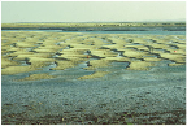Geoscience Reference
In-Depth Information
this inland plateau have largely formed over the last half-million years. The details of
the Anglian events, and of earlier episodes in the Pleistocene, are the subject of much
interest and research at the moment. This will be reviewed briefly in the section on
Landscape
D
that follows this.
Since the Anglian cold phase, the Earth has experienced four more major cold
episodes, the last of which was drawing to a close only about 18,000 years ago. During
this last (Devensian) cold episode, ice from the north extended as far south as the pos-
ition of the present north Norfolk coast. Most of the land to the south, though probably
not covered by ice since the Anglian glaciation, had for much of the time been sub-
jected to viciously cold temperatures, which created a layer of ice within the ground.
The northern latitudes of Canada and Russia provide vivid present-day examples of
ground-freezing processes, and of the ways in which freezing in winter and thawing in
summer can cause damage to the foundations of buildings and roads. East Anglia con-
tains many examples of processes of this sort, preserved since this last cold episode.
FIG
304.
Sandbank in the tidal channel at Wells-next-the-Sea (Fig. 294,
c3
). The large
ripples have a wavelength of about 10 m and become active only when covered by a
tide high enough to flow outwards (to the left) at speeds greater than ≈0.6 m/s (≈2.1 km/
h).
The field shown in Figure 306 has been photographed under ideal conditions of crop
growth to show a regular honeycomb pattern in the ground. Similar patterned effects
are often to be seen in the present-day Arctic (see Chapter 2, Fig. 17), where areas
of ground are subjected to alternations of fierce winter freezing and summer melting.
When the ground freezes, the first ice tends to form at a large number of ice nucleation
points scattered below the soil surface. Once some ice crystals have formed it is easier
for more to grow on these than to grow on their own, so small pockets of frozen ground
form and grow outwards until they meet neighbouring pockets. Here they push against
each other, creating straight edges. Another important effect is that when the water in
the ground freezes it expands, shifting the soil outwards slightly. Where they meet,
neighbouring pockets of frozen ground cannot shift the soil outwards and so force it
upwards to the surface, forming ridges which define the edges of the pockets and pro-
ducing the honeycomb pattern.

